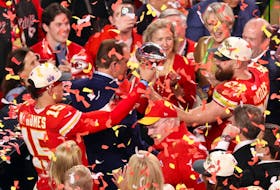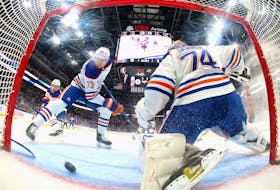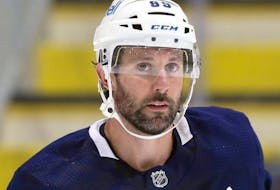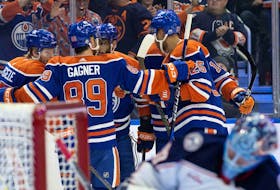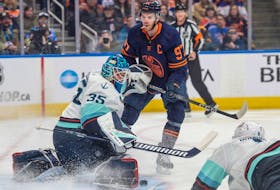Before last summer’s NHL draft, Jim Sandlak made a point of flying into Vancouver two weeks early to visit with some old friends.
There was a barbecue with former teammates Cliff Ronning and Jyrki Lumme at Ronning’s house. Sandlak and his wife Susan had brunch with Sandra and Kalli Quinn and met with Dr. Ross Davidson, the Canucks’ former team doctor, and his wife Linda.
He then returned to his job as a scout with the Anaheim Ducks to prepare for the biggest day on his professional calendar. Still, those few days in Vancouver, a city with which he had a complicated relationship, stayed with the 53-year-old former Canuck.
“I still consider (Vancouver) a second home,” he says over the phone from the Owen Sound area, where he’s riding out the pandemic at his Ontario cottage. “Pat (Quinn, his former coach with the Canucks) was a real mentor for me. I was an only child. I didn’t have brothers and sisters. I’ll never forget the way he took me in.
“I wouldn’t change anything for the world. Did I want to be a 40-goal scorer like I was in junior? Yes. But it’s the hardest league in the world. Maybe I wasn’t good enough.”
Which is what most Canucks fans remember about Sandlak, even if there’s a little more to his story.
This week, as part of our continuing series on some of the more intriguing, less celebrated characters in Canucks history, we look at Sandlak who, over time, has emerged as something of a poster boy for the team’s drafting ineptitude.
Taken fourth overall in the 1985 draft after a 40-goal season with the London Knights and a starring turn with Team Canada at the world juniors, Sandlak was considered a prototypical power forward and a future star.
In the end, he was a dependable third-liner who played 11 NHL seasons, including nine with the Canucks. If he would have been taken in the second or third round, he would have been judged more kindly.
But Sandlak’s career was always about what others expected of him; what others thought him to be. Through no fault of his own, he also arrived in Vancouver in one of the most trying times in the franchise’s ragged history, then watched as Cam Neely was traded away and became the player Sandlak was supposed to be in Boston.
All things considered, it’s a wonder Sandlak remembers Vancouver as fondly as he does, but he’s made peace with everything that was. One of his scouting buddies, Dean Malkoc, once asked him: “House (Sandlak’s nickname, as in big as a house), do you ever have a bad day? Every time I see you you’re smiling.”
And that’s the way the former Canucks remember him: a good teammate and a good guy who loved the game.
Go ahead. You tell him his career was a disappointment.
“If you weighed 220 pounds in those days, they expected you to fight, and it wasn’t in Jim’s DNA to be mean,” said Garry Valk, one of those teammates. “I think if they would have said, ‘Jim, go out there and score 20 goals,’ he would have been fine. But expectations were so high.
“He was a great guy, a really good teammate. But he was a whipping boy for the fans and that was so unfair.”
Sandlak is asked if that experience informs his current work as a scout.
“One hundred per cent,” he says. “It’s not if you’re ready in September. It’s if you’ll be ready in four years.
“It’s a learning process every day that young kids have to go through. It’s a daily grind. I don’t see a lot of 18-year-olds being a saviour in any sport.”
He can speak with some authority on this subject.
Sandlak was the first first-round pick of the newly minted Jack Gordon-Tom Watt hockey department that had taken over from the dearly departed Harry Neale in 1985. Two years before, the Canucks had selected Neely, another size-and-skill right-winger, ninth overall, but Watt never believed the youngster from Maple Ridge would amount to anything.
As it happened, the contract of Boston centre Barry Pederson was expiring and the Canucks were shopping for a No. 1 centre. Pederson had played his junior in Victoria and Nanaimo and averaged more than 100 points a season over a three-year stretch with the Bruins. He had two surgeries to remove a tumour from his shoulder.
Undaunted, the crafty Gordon let it be known the Canucks would sign Pederson as a free agent. Bruins GM Harry Sinden said, fine, we’ll take the compensation — at the time a first-round pick and a roster player. Gordon said wait a minute, let’s make a trade.
Sinden asked for Neely on the recommendation of Bart Bradley, the Bruins’ western scout. Gordon said, OK, but we’ll give you a first-rounder in 1987, thinking Pederson would lift the Canucks into the playoffs.
You know what happened next. Pederson had a couple of decent 70-point seasons with the Canucks, but he wasn’t the player he’d been before the surgeries and the Canucks finished 19th in the 21-team league in 1986-87.
Neely would go on to have a Hall of Fame career. The first-rounder turned into Glen Wesley, who played just under 1,500 NHL games. It remains among the worst trades in NHL history.
Sandlak, meanwhile, started the 1985-86 season with the Canucks when he was still 18 and promptly scored one goal in 23 games. He was sent to the world junior team, then back to London, before securing a regular place in the Canucks’ lineup the next year.
His stats line — 15-21-36 in 78 games — was respectable for a 19-year-old rookie. The problem was Neely scored 36 goals in Boston that year.
“It was tough,” Sandlak said. “Vancouver didn’t have any fans. They told me to jump right in and get’er going. There wasn’t the guidance and all the stuff they have now. It’s all done for you now. You just connect the dots. It was tough for a teenager.”
And it never got any easier.
There were some highlights, to be sure. Twenty goals in 1988-89. A big playoff series against the Winnipeg Jets in 1992 when he played on a line with Sergio Momesso and Ronning — “That was so much fun,” he said. “We got death threats in Winnipeg.”
But he was never more than a third-liner in his time with the Canucks, and he was eventually traded to Hartford in 1993 in a deal that brought Murray Craven to the Canucks.
Quinn brought him back to Vancouver for one more year in 1995-96, his last season in the NHL. That meant something to Sandlak. And still does.
“Pat once told me this game is a correlation to life,” Sandlak says. “I’m a young guy, 21, just starting out and I go, ‘What do you mean?’”
Quinn then told Sandlak to consider the airplane. Does it fly with its nose in the air? No. Does it fly with its nose pointed to the ground? No. It flies with its nose pointing straight ahead and that’s how you should be in hockey and life. Even keel. Moving forward. Letting the wind carry you.
“I remember I had five points in Philly one night, then nothing for two weeks,” Sandlak says. “Pat called me over and said, ‘How’s your airplane flying? Get your nose level and let the wind carry you.’ To this day I pass that on to the kids we draft.”
That and so much more.
CLICK HERE to report a typo.
Is there more to this story? We’d like to hear from you about this or any other stories you think we should know about. Email [email protected] .
Copyright Postmedia Network Inc., 2020


